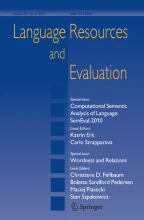Abstract
In this paper we present an annotated audio–video corpus of multi-party meetings. The multimodal corpus provides for each subject involved in the experimental sessions six annotation dimensions referring to group dynamics; speech activity and body activity. The corpus is based on 11 audio and video recorded sessions which took place in a lab setting appropriately equipped with cameras and microphones. Our main concern in collecting this multimodal corpus was to explore the possibility of providing feedback services to facilitate group processes and to enhance self awareness among small groups engaged in meetings. We therefore introduce a coding scheme for annotating relevant functional roles that appear in a small group interaction. We also discuss the reliability of the coding scheme and we present the first results for automatic classification.
Similar content being viewed by others
References
Bales, R. F. (1970). Personality and interpersonal behavior. New York: Holt, Rinehart and Winston.
Benne, K. D., & Sheats, P. (1948). Functional roles of group members. Journal of Social Issues, 4, 41–49.
Brdiczka, O., Maisonnasse, J., & Reignier, P. (2005). Automatic detection of interaction groups. In Proc. of the 7th International Conference on Multimodal Interface, Trento, Italy.
Carli, G., & Gretter, G. (1992). A start-end point detection algorithm for a real-time acoustic front-end based on DSP32C VME Board. In Proc. ICSPAT.
Chen, L., Rose, R. T., Parrill, F., Han, X., Tu, J., Huang, Z., Harper, M., Quek, F., McNeill, D., Tuttle, R., & Huang, T. (2005). VACE multimodal meeting corpus. In Proc. of Multimodal Interaction and Related Machine Learning Algorithms.
Chippendale, P. (2006). Towards automatic body language annotation. In Talk delivered at the International Conference on Automatic Face and Gesture Recognition – FG2006 (IEEE), Southampton, UK.
Cristianini, N., & Shawe-Taylor, J. (2000). Support vector machines and other kernel-based learning methods. Cambridge: Cambridge University Press.
Dietterich, T. G. (2002). Machine learning for sequential data: A review. In T. Caelli (Ed.), Lectures Notes in Computer Science. Springer-Verlag.
Falcon, V., Leonardi, C., Pianesi, F., & Zancanaro, M. (2005). Annotation of group behaviour: A proposal for a coding scheme. In Proc. of Workshop on Multimodal Multiparty Multimodal Processing at ICMI 2005, pp. 39–46.
Hall, J. W., & Watson, W. H. (1970). The effects of a normative intervention on group decision-making performance. Human Relations, 23(4), 299–317.
Hare, P. (2003). Roles, relationships, and groups in organizations: Some conclusions and recommendations. Small Group Research, 34(2), 123–154.
Hsu, C.-W., & Lin, C.-J. (2002). A comparison of methods for multi-class support vector machines. IEEE Transactions on Neural Networks, 13, 415–425.
Kaiser, E., Demirdjian, D., Gruenstein, A., Li, X., Niekrasz, J., Wesson, M., & Kumar, S. (2004). A multimodal learning interface for sketch, speak and point creation of a schedule chart. In Proceedings of ICMI 2004, pp. 329–330.
Katz, D., & Kahn, R. L. (1978). The social psychology of organizations (2nd ed.). New York: Wiley.
Kressel, U. (1999). Pairwise classification and support vector machines. In B. Scholkopf, C. J. C. Burges, & A. J. Smola (Eds.), Advances in Kernel methods – Support vector learning. Cambridge, MA: MIT Press.
Landis, J. R., & Koch, G. G. (1977). The measurement of observer agreement for categorical data. Biometrics, 33, 159–174.
McCowan, I., Gatica-Perez, D., Bengio, S., Moore, D., & Bourlard, H. (2004). Towards computer understanding of human interactions. In E. Aarts, R. Collier, E. van Loenen, & B. de Ruyter (Eds.), Ambient intelligence. Lecture Notes in Computer Science (pp. 235–251). Heidelberg: Springer-Verlag.
Otzuka, K., Yamato, J., Takemae, Y., & Murase, H. (2005). A probabilistic inference of multiparty-conversation structure based on Markov-switching models of gaze patterns, head directions, and utterances. In Proceedings of IMCI’05, Trento, Italy.
Pianesi, F., Zancanaro, M., Falcon, V., & Not, E. (2006). Toward supporting group dynamics. In Proceedings of AIAI’06, Athens.
Rienks, R., Zhang, D., Gatica-Perez, D., & Post, W. (2006). Detection and application of influence rankings in small group meetings. In Proceedings of ICMI’06, Banff, CA.
Salazar, A. (1996). An analysis of the development and evolution of roles in the small group. Small Group Research, 27, 475–503.
Stiefelhagen, R., Zhan, J., & Waibel, A. (2002). Modeling focus of attention for meeting indexing. In CHI ‘02 extended abstracts on Human factors in computing systems.
Waibel, A., Steusloff, H., & Stiefelhagen, R. (2004). CHIL: Computer in the human interaction loop. In NIST ICASSP Meeting Recognition Workshop, Montreal, Canada.
Zancanaro, M., Lepri, B., & Pianesi, F. (2006). Automatic detection of group functional roles in face to face interactions. In Proceedings of International Conference on Multimodal Interaction, Banff.
Zhang, D., Gatica-Perez, D., Bengio, S., & Roy, D. (2006). The team-player influence model. Pattern Analysis and Machine Intelligence.
Acknowledgements
This work has been partially supported by the EC under contract no 506909, to the CHIL project (FP6).
Author information
Authors and Affiliations
Corresponding author
Rights and permissions
About this article
Cite this article
Pianesi, F., Zancanaro, M., Lepri, B. et al. A multimodal annotated corpus of consensus decision making meetings. Lang Resources & Evaluation 41, 409–429 (2007). https://doi.org/10.1007/s10579-007-9060-6
Received:
Accepted:
Published:
Issue Date:
DOI: https://doi.org/10.1007/s10579-007-9060-6
